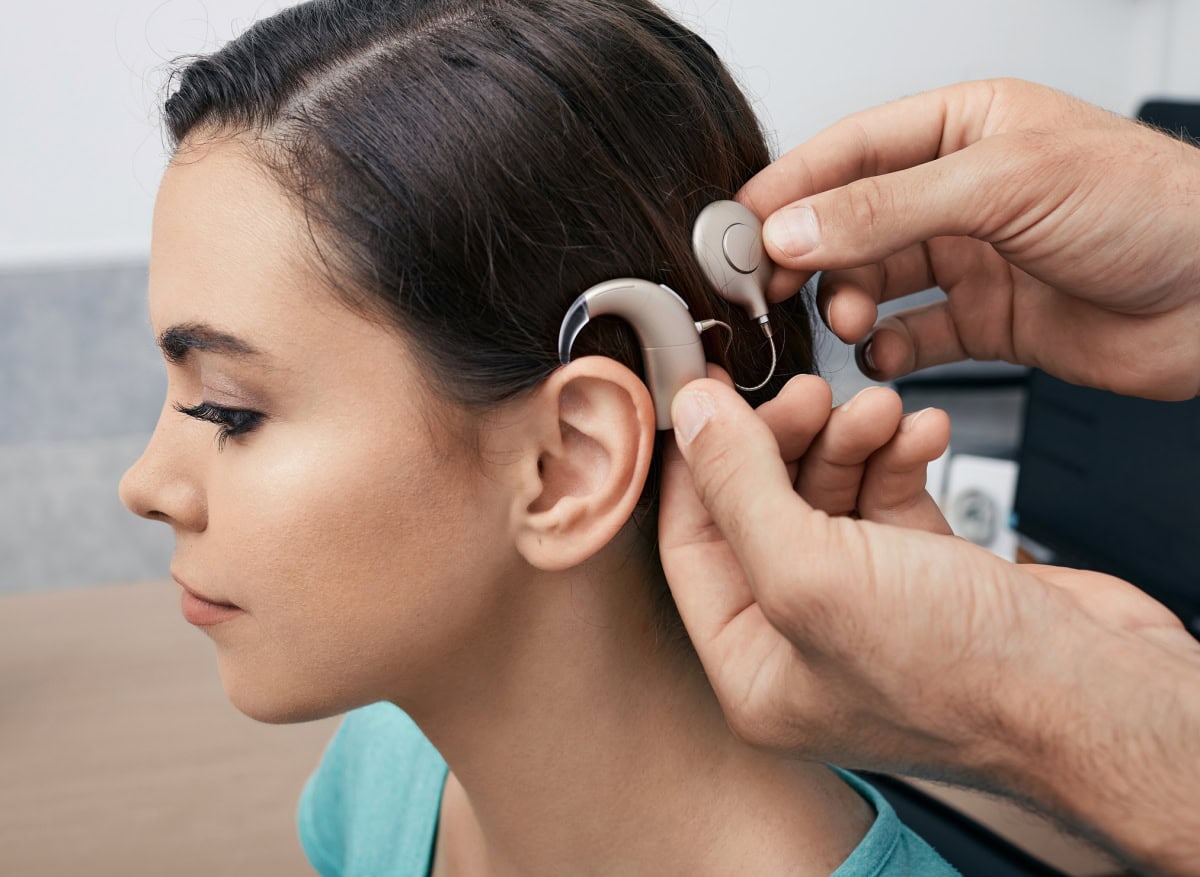
Hearing aids and cochlear implants are typically the options presented by individuals with hearing loss. While both devices aim to support hearing, they work in fundamentally different ways and are suitable for different degrees of hearing loss. Understanding the difference between these two options is crucial for making an informed decision that is appropriate to your individual needs and lifestyle.
Understanding Hearing Aids
What Are Hearing Aids and How Do They Work?
Hearing aids work amplifying sound so you can hear better and engage with your environment despite your hearing loss. These devices capture sound through a microphone, amplify it, and then deliver it to your ear.
This is typically worn in or behind the ear.
Types of Hearing Aids
- Receiver in the Canal (RIC):In the RIC style, the receiver (or speaker) is positioned inside the ear canal and connected to compact hearing aids that sit discreetly behind the ear via a nearly invisible wire. This option is suitable for all types of hearing loss and is ideal when seeking a discreet solution that leverages the latest technology while ensuring maximum comfort.
- Completely Inside the Canal (CIC):CIC hearing aids are designed to fit almost entirely within the ear canal, making them virtually undetectable. This type of hearing aid could be beneficial if you have mild to moderate hearing loss and desire discreet devices that are barely noticeable.
- Inside the Canal (ITC):They are located inside the ear canal, providing comfort with reduced visibility. These aids are appropriate if you have mild to moderate hearing loss and have a more active lifestyle.
- Inside the Ear (ITE):These hearing aids fit snugly inside the ear, providing a high level of comfort and easy usability. They could help you if you are experiencing mild to moderately severe hearing loss. They are also comfortable and easy-to-handle options.
- Behind the Ear (BTE):They are placed discreetly behind the ear, connecting to the ear via a tube and earmold. They are usually for all degrees of hearing loss and are available in a traditional style at various price points.
Local Availability
Hearing centres in Singapore offer a wide selection of hearing aids from various brands and providers. Some of the common brands used by those with hearing loss include Unitron and Phonak. Their hearing devices come with features that could help optimise your auditory experience. From noise reduction to Bluetooth connectivity, there are hearing aids designed to potentially accommodate diverse needs and preferences.
Understanding Cochlear Implants
What Are Cochlear Implants and How Do They Work?
Cochlear implants are designed to give you a sense of sound if you have severe to profound hearing loss. They work by bypassing the damaged parts of the ear and stimulating the auditory nerve directly. This allows you to perceive sounds that you would not be able to hear otherwise.
Components and Function
There are two main components in a cochlear implant:
- External Processor: This device is worn behind the ear and captures sound. It converts sounds into digital signals and transmits them to the internal implant.
- Internal Implant: Surgically placed under the skin, this component receives signals from the external processor and sends electrical impulses to the auditory nerve, allowing the brain to interpret them as sound.
Who Can Benefit?
Cochlear implants may be a suitable option if you have profound hearing loss and do not find hearing aids helping them in their hearing situations. It could also be useful for those who have lost their hearing due to an issue in their inner ear.
Local Availability
Cochlear implant services are typically available in Singapore, including surgical procedures and post-operative care. There are hearing and medical centres that provide cochlear implant procedures along with comprehensive support throughout their recovery and adjustment period.
Comparing Cochlear Implants and Hearing Aids
| Features | Cochlear Implant | Hearing Aid |
| Mechanism of Action | Electrically stimulates the auditory nerve | Amplifies sound |
| Suitability for Hearing Loss | Severe to profound hearing loss | Mild to severe hearing loss |
| Surgical Procedure | Requires surgery | Non-surgical |
| Benefits | Can provide clearer sound perception for those with profound hearing loss | Non-invasive, adjustable settings, affordable |
| Drawbacks | Surgical risks, longer adjustment period, expensive | Limited effectiveness for profound hearing loss, potential feedback issues |
| Daily Use and Maintenance | Requires regular charging and occasional cleaning of the external parts | Requires battery changes or charging and daily maintainence cleaning |
| Comfort and Convenience | May require an adjustment period to get used to the sensation of electrical stimulation | Generally comfortable to wear, with various styles available for different preferences |
| Aesthetic and Practical Factors | External part is visible behind the ear | Can be discreet or invisible, depending on the style |
Cochlear Implants vs Hearing Aids: Benefits and Drawbacks
Hearing Aids
Pros:
- No surgeries are needed when using hearing aids, making them accessible.
- These devices can be customised to match your specific hearing needs and preferences.
- They could help in addressing mild to severe hearing loss.
- Some devices are often available for immediate use after assessment, providing a fast solution to hearing challenges.
Cons:
- It may only provide limited amplification for those with severe auditory impairments.
- Sound distortion or whistling may occur in some cases when not adjusted properly, which could be uncomfortable.
- Regular adjustments and servicing may be required to ensure your hearing device works at optimal performance.
H3Cochlear Implants
Pros:
- They help convert sound into electrical signals to stimulate the auditory nerve, offering clearer sound perception.
- They could potentially enhance the understanding of speech and social interactions.
Cons:
- While cochlear implants may provide potential benefits, what holds some patients back from this option is its potential side effects, which include injury to the facial nerve, meningitis, and even cerebrospinal fluid leakage.
- In some cases, sound distortion or whistling may occur when not adjusted properly, which could be uncomfortable.
- Regular adjustments and servicing are necessary to ensure optimal performance.
Lifestyle Considerations
When choosing the right hearing device, it’s important to evaluate your lifestyle and consider the following:
Daily Use and Maintenance
When it comes to daily use and maintenance, hearing aids typically require a bit more attention. Regular upkeep includes changing batteries or charging and daily simple cleaning of the hearing aid depending on the device and usage. You may also need periodic hearing aid fine-tuning by an audiologist or hearing care consultant to ensure the settings remain optimal for your needs.
On the other hand, cochlear implants generally demand less daily maintenance. While you will not need to change batteries as frequently, you will need to engage in ongoing adjustments and follow-up care to refine the device’s programming and functionality. This can involve multiple visits to healthcare professionals, especially during the initial adjustment period after surgery. Ultimately, understanding the maintenance requirements for each option helps you make an informed choice that aligns with your lifestyle.
Comfort and Convenience
Comfort and convenience are significant factors when selecting between hearing aids and cochlear implants. Hearing aids are designed for user-friendliness, allowing for immediate use after fitting, which can be particularly beneficial if you are looking for prompt solutions for your hearing challenges. Many modern hearing aids have features like automatic adjustments to different sound environments, ensuring a seamless auditory experience.
However, cochlear implants may require a learning curve as users adapt to a new way of hearing that differs from what they are accustomed to. The adjustment period will vary from person to person, with some finding it easier to transition than others.
Overall, while both devices aim for comfort, users must be prepared for the different levels of adaptation required, especially with cochlear implants.
Aesthetic Factors
Aesthetic considerations may also play a significant role in choosing between hearing aids and cochlear implants. Hearing aids come in various styles, including discreet options such as completely-in-the-canal (CIC) and receiver-in-the-canal (RIC) models, making them less noticeable to others. This allows users to select a device that aligns with their personal style and comfort level regarding visibility.
In contrast, cochlear implants are more visible because of their external components.
How The Hearing Solution Group Can Help
Knowing the difference between cochlear implants and hearing aids is important so that you can make informed decisions about your hearing health. To help you navigate this important choice, The Hearing Solution Group offers comprehensive services and expert guidance. Our audiologists and hearing care consultants can conduct a comprehensiveaudiometer hearing test, discuss your individual needs, and recommend suitable solutions for your condition. Other services provided include device fitting and adjustments, ongoing follow-up care and more. Additionally, you can discover educational workshops and support groups to help you get more information about your condition and connect with others on a similar journey.

 Find Us
Find Us Call Us
Call Us
